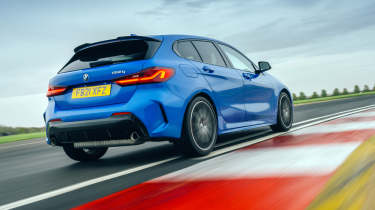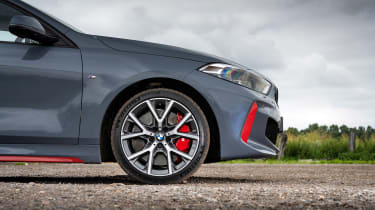BMW 128ti (2020 - 2024) review – does BMW's first front-drive hot hatch have the GTI beat?
BMW's first front-drive hot hatch has some issues against more focused rivals, but is very well priced and does enough to worry the basic Golf GTI
If you are going to build your first front-wheel drive hot hatch there are some softer targets to go after than the Golf GTI. A 50 year legacy, a loyal band of followers the world over and a track record of delivering without exception (ignoring the Mk3 and Mk4, obviously). So BMW needs a pat on the back for stepping off at the deep end into the GTI’s territory with its first front-wheel drive hot hatch – the 128ti.
If the idea of a front-drive performance BMW model fills you with dread, don’t start sticking pins in your BMW doll just yet, because the 128ti features a skunkworks-like collection of subtle chassis and powertrain modifications that should sharpen the package while also bringing it down a notch from the premium performance hatchback class the more expensive M135i operates in.
> Hot hatchback battle: the middleweights
There’s nothing revolutionary about the 128ti’s engine, it follows the safe and steady route of using a turbocharged 2-litre four-cylinder engine as found across the BMW and Mini line-ups, from the Cooper S to a plethora of saloons and SUVs.
In the 128ti there’s 265hp and 295lb ft torque at your disposal, the former between 4750 and 6500rpm, the latter spread from 1750 through to 4500rpm, and both are up on the basic GTI. Although like the Golf, the BMW is on the portly side at 1445kg which pegs its sprinting capability back to 6.1sec. That might sound like an age in 2021 but from behind the wheel you never feel that you are being left behind.
More reviews
An eight-speed auto gearbox is the only option, though it is hooked up to a limited-slip diff as standard. The gear selector is mounted curiously low, at a bit of a stretch, and the seats’ plump cushioning gives me the sense I’m sitting on the car rather than in it. But the sense of quality in the cabin is excellent, making it one of the plushest-feeling interiors in its segment.
Go-faster ‘ti’ stickers are fitted to quite a few 128tis as standard, but the Misano Blue car we tested has been optioned without them. Also optional are the 19-inch wheels (18s are standard), and on the 128ti’s passive dampers the ride is very busy. There’s no option of adaptive dampers, which is a shame, as you sense it would transform the ride. The 128ti has been given a much stiffer suspension set-up than the M135i, and its jiggly ride can be quite wearying on the road, although it is involving. There’s a fair bit of torque steer too, more so than in many of the other cars here, on the cusp between characterful and unruly.
The Golf GTI, on optional adaptive dampers (£875), has a much more composed ride. Subjectively, the 128ti is more engaging and honest in feel, almost like a classic hot hatch, but there are times it can feel a bit disjointed on the road – fun but not totally fluid in terms of its steering response and body movement.
On Bedford’s smooth track surfaces, the 128ti feels much happier and is a composed, connected car to steer. Like many other hatches, it struggles for turn-in grip on the chilly, slippery track surface (and it’s worth noting that our test car isn’t on brand-new tyres) but it felt more at home on the circuit than many of the other cars.
Jos van As (BMW’s head of driving dynamics) and his One Series chassis development team were tasked with developing the 128ti, their remit to make it as light as possible without compromising refinement but retaining a focus on it being a hot hatch and about all else fun.
Taking a M135i xDrive, they ditched that car’s four-wheel drive system and removed the front chassis bracing. They also adjusted the geometry at all four corners, fitted springs that were eight percent stiffer and 10mm lower, and the standard passive dampers were given a higher compression rate. Anti-roll bar stiffness was also increased, so too were their mounts. 18-inch wheels are standard (19s are optional) with a Michelin Pilot 4 tyre fitted.
There’s a slower steering ratio compared to that of the 135i and the diff ratio under acceleration is five percent slower. Overall the 128ti weighs 80kg less than the M135i xDrive, although a small hot hatch with a kerb weight over 1400kg still feels portly to us.
The softer locking characteristics of the limited-slip differential compared with the 135i xDrive is instantly felt, but I’m not sure this was a great idea. It has arguably reduced the sense of connection and control over the front wheels in a straight line, and then pulling out of corners with some steering angle you can still feel the inside wheel losing traction rather than the whole front end digging in and tightening the line as it does in a Golf.
Even more concerning for the BMW is the fact that its drivetrain feels like the weakest link. You could argue that sounds surprising, because with 261bhp it’s more powerful than a Golf and base Cupra Leon, but it’s still behind the Hyundai i30 N (276bhp) and its 295lb ft of torque is a match for the class norm. But I don’t think it’s the engine’s fault; I think it is down to the automatic gearbox. In isolation you can get used to it, but the moment you put it back-to-back with the dual clutch ’boxes found in rivals it suddenly feels like using a spoon to cut your food instead of a steak knife. The whole delivery just seems slightly soft and lacking in urgency, even with Sport+ mode engaged.
Prior to the 128ti’s launch in 2020, BMW didn’t really have a hot front-wheel-drive car in its line-up. The result isn’t an all-time great but there’s much to like about the 128ti. You could argue for either 1-series variant but ultimately the 128ti gets the nod over the M135i, because the more powerful, more expensive car still feels broadly like a front-wheel-drive car with extra grip rather than possessing a character all of its own, and the 128ti’s extra sense of character and connection is ultimately more rewarding than the M135i’s extra pace and composure.






